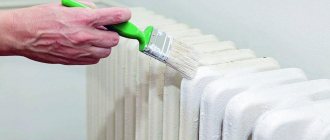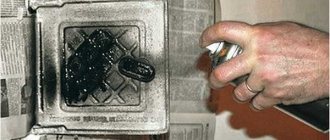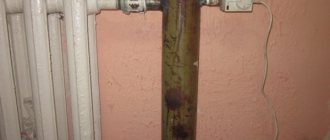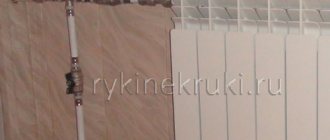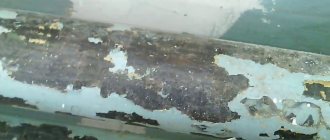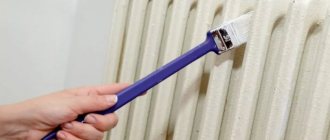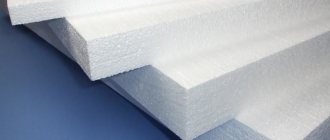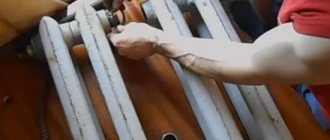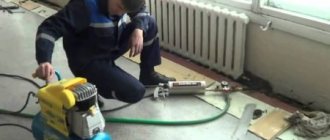You may have already faced the question of how to paint radiators, and if you solved it, then that’s, of course, good. If not, then you will find out about it now. The peculiarities of such painting work lie not only in paint and varnish materials, but also in finishing tools, as well as the heaters themselves, which can also be different.
So, if you want to choose a paint composition that is exactly suitable for your case, stay with us. And the video in this article will complement our material with visual information.
Painting radiators: a creative approach
Which paint to choose for aluminum or cast iron radiators
It should be noted that each type of metal has its own paint and painting technology:
- Cast iron is characterized by excellent adhesion to almost any type of enamels. In this case, you should be guided by the effect you want to achieve after coloring. Paint with a dense viscous structure will hide the rough texture, while light paint, on the contrary, will emphasize the effectiveness of cast iron.
- Aluminum and stainless steel are more capricious in choosing the appropriate paintwork. The painting technique used at the factory (powder coating and heat treatment) is practically not feasible at home. Therefore, priority is given to high-quality painting materials with a high adhesion coefficient - alkyd or acrylic. Some experts talk about the effectiveness of aerosol paints, moreover, applied to hot batteries.
Epoxy primers designed for treating metal before painting will help enhance the adhesion effect.
Tools and materials
Stages of painting batteries.
- drill brush;
- drill;
- washing solutions;
- paint brush;
- film;
- putty knife;
- sandpaper;
- White Spirit;
- anti-corrosion primer;
- smooth roller;
- brush;
- dye.
The advantage of using special removers is that these products are harmless. They can only affect layers of paint without affecting the metal. After getting rid of the old paint, the surface must be treated using sandpaper; one should not forget about degreasing. To do this, you need to use a slightly alkaline solution, such as white spirit. As a final preparation step, before you start painting, apply a layer of anti-corrosion primer to the battery. After the above steps have been completed, the surface can be considered prepared; the paint will adhere perfectly to such a base, because the product prepared for painting has excellent adhesive characteristics.
How to paint radiators and heating pipes
Calculating paint consumption
First you need to calculate the approximate area of the batteries. For one section of old cast iron it is approximately 0.25 square meters. m. The total area of the radiator is equal to the number of sections multiplied by this number. With bimetallic radiators it is somewhat more complicated. Most of the outer side of the section is a rectangle, but at the top there is fins of a complex configuration.
Next, you should find out what paint consumption will be per unit area (this depends on the specific paint composition). Multiply it by the calculated area of the heating device, then by the number of coating layers.
This way you can make an approximate calculation of the consumption of the applied coating. At least one-fifth better, buy it with a reserve.
Tools
We will need:
- Brush with a metal base.
- Brushes – regular and radiator.
- Coarse sandpaper.
- Small brush for cleaning.
- Sharp metal spatula.
- Primer for metal.
- Dye.
- Degreasing composition.
Preparing for coloring
It consists of the following stages:
- Cleaning the battery from accumulated debris and dirt. This can be done with a vacuum cleaner, brush or damp cloth with detergent.
- Removing paint and rust from the radiator. The procedure is carried out mechanically and chemically.
The first consists of a long, tedious process of stripping off the previous coating with a wire brush. You can use a grinder with a special attachment or a grinding wheel.
The chemical method involves the use of special aerosol formulations, gels or pastes. They should be applied to the battery, wait as long as indicated on the composition label and clean the paint with a spatula.
- Cleaning the radiator from cracks, scratches and other minor defects. Use sandpaper or a wire brush.
- Degreasing the surface.
- Padding. Choose the composition that matches your paint and battery metal.
What paint are used on radiators?
You can select a sufficient number of products that are suitable for the job.
Alkyd enamels
This option is considered traditional when painting metal heating elements. The mixture has the following advantages:
- Low cost. The availability of the material explains its popularity.
- Easy to apply. The solution is excellent for cast iron radiators and does not require prior priming.
- Wide decorative range. There are paints of different shades on sale that can be mixed successfully. There are also colors.
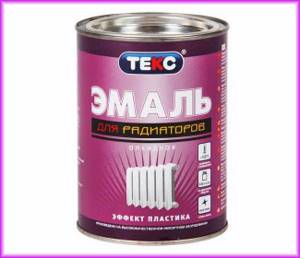
The product is not without its shortcomings:
- Persistent smell. Complete weathering occurs only after the coating has completely dried.
- Change in color over time. Gradually, due to high temperature, the surface may acquire a whitish or yellowish tint.
Oil paint
This variety is still found on sale, although its demand is low. This is explained by the mass of negative properties that the material has. Especially noticeable is the long drying period and the pungent odor, which has a toxic effect. Such compositions are used only in cases where there is no alternative.
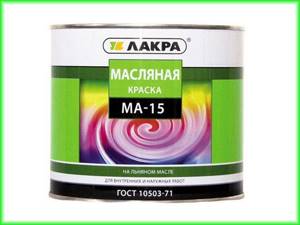
Water-based variety
This type of coloring product, or rather its polymer variety, is considered new. That is why the question arises: is it possible to paint batteries with water-based paint?
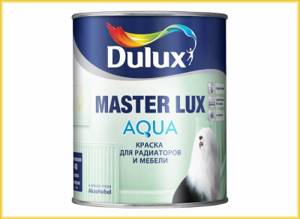
Yes, this composition is used to work with heating elements, but despite all the positive qualities (durability, environmental friendliness, ease of installation, absence of a pungent odor), the product has certain conditions of use. They are:
- The acrylic option is the most acceptable variety.
- To paint a product with high quality, it is better to use a spray gun. When painting by hand, avoid excessive dilution with water.
- The base must be treated with anti-corrosion compounds and primed.
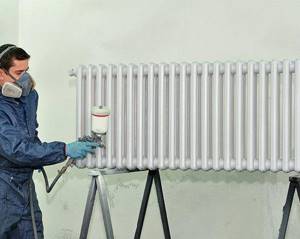
Serebryanka
This variety is considered a classic, but is rarely used. This is due to the fact that the surface acquires a metallic (silver or aluminum) color. You can make the composition yourself or buy a ready-made one. The basis of the mixture is aluminum powder.
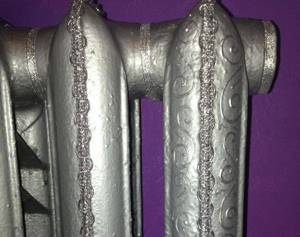
An expensive but high-quality alternative is silicone-aluminum paint. It has the necessary parameters and creates a layer that does not crack due to thermal expansion.
Painting works
LMB
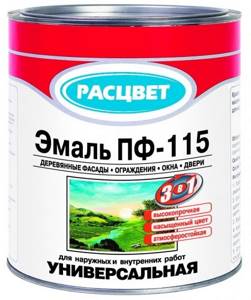
Universal enamel PF-115
Most often, glyphthalic and pentaphthalic coatings are used for painting work on radiators. That is, the surface is primed with GF and coated with PF enamels.
The color range of the compositions most often suits all consumers, since the primers have several shades of gray, as well as red, blue and black. This is quite enough for all PF enamels.
And the service life here fully meets all the requirements - with proper painting, its shelf life will be at least 8-10 years, and in some cases even more, unless, of course, the requirements of the decoration are taken into account.
Paint for heating radiators
In addition to this, there are a number of other paintwork materials that can be used for painting work in such cases, for example:
- EMPIRE,
- TUTGUM
- AIPINA HEZKOROER,
- POLIFARB and so on.
But if you are wondering whether it is possible to paint batteries with acrylic paint, then pay attention to its heat resistance, which in such cases should be at the level of 95-100⁰. This is indicated in the instructions for the acrylic paint you see in the photo above.
It is noteworthy that the cost of such radiator paint, as in the top photo, is quite affordable and amounts to about 120 rubles per can, which looks very attractive in relation to its service life.
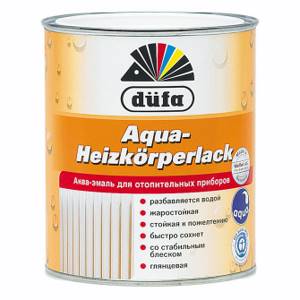
Aqua-Heizkorperlack – white enamel for heating devices
Real enamel is ready for use, it is made on the basis of 100% acrylic. The main advantage of acrylic enamel is its unusually high heat resistance until yellowing - 120⁰C - we can say that it will not turn yellow at all on batteries in domestic conditions.
The composition is diluted with water, and its consumption is about 1 l/13 m2; as a result of treatment, the surface acquires a glossy shine. Complete drying of Aqua-Heizkorperlack at a temperature of 19-23⁰C and air humidity up to 65% occurs after 10 hours, but if necessary, a second layer can be applied after 3 hours.
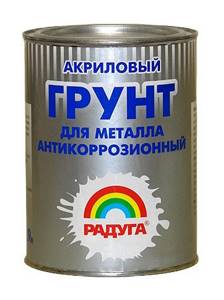
Acrylic anti-corrosion primer VD-AK 0150
Some netizens are wondering whether it is possible to paint batteries with water-based paint, but the answer here will be conditional. Of course, you can paint with water-based emulsion, but how long will such a coating last for you? At best, for a year, but maybe less, and besides, the appearance of the surface here will be far from the best.
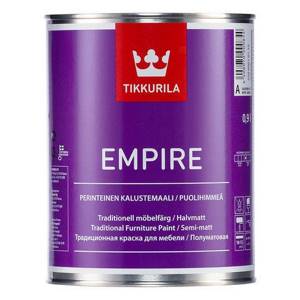
TIKKURILA Empire – general purpose alkyd thixotropic
In addition to radiators, TIKKURILA Empire can also be used for furniture, window and door frames inside and outside the building, garden furniture and, of course, for any metal surfaces. Almost all painting tools can be used for application.
But if it is a sprayer, then TIKKURILA Empire is diluted with white spirit to reduce the viscosity. The treated surface dries at a temperature of 19-23⁰C and air humidity up to 65% within 24 hours, but the next layer can be applied after 3 hours.
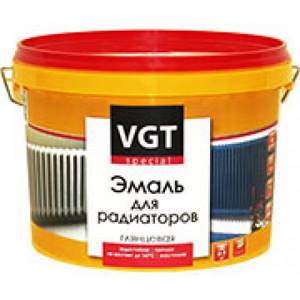
VGT VD-AK-11179 enamel for radiators
VD-AK-11179 “PROFI” creates a glossy surface that is susceptible to high temperatures - short-term heating of the metal up to 160⁰C is possible without any consequences. If necessary, you can change the color of the paintwork - for this purpose, use tinting pastes from VGT. The retail price of one can is about 110-120 thousand rubles.
Note. It should be noted that electrically conductive paint ZINGA can be used for heating devices, since this is a variant of cold galvanizing of metal. But it makes no sense to use fire-retardant paints on POLYSTIL metal - such a coating is intended for temporary protection from open fire, which has nothing to do with batteries.
Tools
Curved brushes for sectional radiators
Considering the configuration features of such devices, it is quite difficult to paint them with ordinary brushes, and even more so with paint rollers. To be more precise, alik is not appropriate here at all, since it cannot cover even a third of the area.
So to get to the hidden corners between sections with your hands, your best bet is to use curved brushes - they come in different widths, so you may need several options.
Universal combination brushes
If you are lucky, then buy universal combination brushes - for some reason they are practically not on sale, although they are a very convenient painting tool for blind areas on the surface being treated. Their versatility lies in the brushes, which are rotated 135⁰.
This makes it possible to reach the opposite side of the section. If you do not dismantle, then these tools will help you to carry out high-quality painting work. Painting is done in the usual way, that is, here you just need to comply with the requirements that are presented by the manufacturer on the can of paintwork.
Preparation
Note. Cast iron radiators require regular painting, which means it is quite natural that the instructions given below apply specifically to them, as well as to types of paintwork materials.
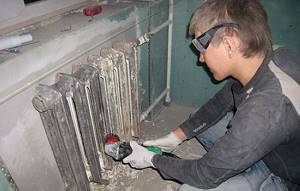
Cleaning old paintwork
Painting in any case involves certain stages, which are as follows:
- a new paintwork material with any base will exactly repeat the most insignificant details of the surface topography. Therefore, if the old layer is cracked or even begins to peel off, then it should be completely cleaned down to the metal;
- but how to remove the paint from the battery is up to you , but here you can use either a metal brush or a special remover;
- the brush can be manual , but they are also made in the form of attachments for an electric drill or grinder;

Super remover Zip-Strip
- The cleanest way to remove the old layer of paintwork is possible using washes , which may have different “powers”. For example, for the Zip-Strip composition, which is shown in the top photo, this indicator is determined by 8 (eight!) layers of paint at a time!
- but be that as it may, any composition is applied to a degreased surface for 5-10 minutes , until the coating begins to crack or bubble, after which it is removed with matting, a chisel or a spatula. But latex and epoxy paints do not show visual signs when softened, that is, they do not crack or swell. Therefore, readiness here is checked experimentally.
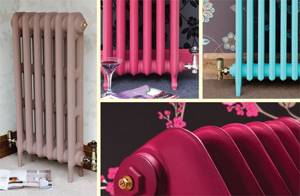
A radiator can become an attractive decorative element
How to choose the right paint and paint a radiator
Heating radiators are an inconspicuous element of our home and fit harmoniously into its interior if they are new, shining with fresh paint. But if the batteries are already old, the paint on them is faded and swollen, then in this state they are striking and are unlikely to decorate the house. The problem can be resolved by replacing the batteries. But this is expensive and not always justified, so there is another option - to repaint the batteries. For this purpose, special paint for heating radiators is used. Its purpose is to protect the surface of the batteries from corrosion, giving them the desired color, as well as a decent appearance. And if earlier pipelines were painted only white, now they are painted in the color that best suits the design of the room. Our article will discuss what paint to choose for heating radiators and how to paint them correctly.
Surface preparation
When preparing to paint, it is important to thoroughly prepare the surface to be painted. It is better to do the work in the summer, when the radiator is cold. If you have to paint during the heating season, you should turn off the hot water supply and wait a few hours for the radiators to cool down.
Attention! The maximum permissible temperature of the painted surface cannot exceed +30 degrees Celsius. At higher temperatures, the paint will dry too quickly and will not adhere firmly.
Painting a radiator is not a difficult task, but it requires the use of special paints and varnishes. Paint without a strong odor will provide an aesthetic appearance and comfort during further operation of the heating system.
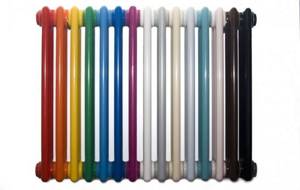
It is necessary to properly prepare the surface to be painted and ensure drying conditions. Sometimes even a special paint for painting batteries with increased heat resistance and excellent adhesion to the surface can become damaged during operation - cracks and irregularities will appear.
Why do adverse events occur despite the use of specialized products? The main reason is improper surface preparation.
Old cast iron and steel batteries must be carefully prepared before being repainted:
- The surface must be clean, dry and smooth.
- First, you should remove the old coating (if it is peeling off), thoroughly wipe the ribs with abrasive paper, wipe, and dry.
- The surface of the battery must be dry, free of dust, with degreased water and detergent.
- Old rusty coatings, rust should be removed using a wire brush or sandpaper.
- Copper elements should be rubbed with steel wool to remove dirt and patina.
- The metal parts of the radiator must be primed, preferably with an anti-corrosion primer.
Choosing colors for heating appliances
A home craftsman may be faced with the question of what paint to choose for radiators. The solution to this issue depends on the preferences of the owner.
The classic option is heating devices painted with white radiator paint. In Soviet times, all cast iron batteries had this color. The heat transfer efficiency of a radiator depends on color to a very minimal extent. Consequently, heating devices may well correspond to the overall interior of the room.
Today, designers offer a large number of solutions in which the radiator acts as a decorative element and fits harmoniously into the interior of the room.
In some cases, radiators are painted in bright rich colors, thereby focusing attention on this element. The result is a composition based on contrast.
Recently, when deciding what color to paint radiators, you can notice the growing popularity of the ombre technique. In this case, the first section is pale in color, and each subsequent section is one or two shades darker. The last section is painted in a bright, rich color.
Radiators in a children's room can be painted with interesting designs or painted in different colors.
Painting heating appliances does not require special knowledge or skills. Having studied the intricacies and nuances of this process, you can do the work yourself. And if you follow the painting technology and correctly determine what paint to paint cast iron batteries with, you can get a high quality result.
Reasons for failure
A common reason for unsatisfactory painting results is failure to comply with the enamel drying conditions. It is risky to carry out work during the heating season, when the batteries can turn on and heat up. This common mistake usually ends in an unsightly result. High temperatures cause drying too quickly, weakening the resulting coating. Radiators can be painted at room temperature. Paints are resistant to temperatures up to 100 degrees Celsius, however this does not mean that they can be applied at such temperatures.
Conclusion Hiding old radiators behind heavy curtains or furniture is not a good idea. By hiding radiators behind curtains, we restrict the flow of heat, reducing heating efficiency. Old, cast iron, steel batteries can be quite effective, they are durable and reliable, so replacement is not always advisable. However, it is difficult to consider them as a decorative element of the interior. Modern means can correct an aesthetic defect - old radiators can be painted. In order to get a beautiful, durable end result, it is important to properly prepare the surface, choose the right way to paint the batteries, choosing a paint with good resistance to high temperatures.
Is it possible to paint hot radiators?
When painting heating radiators and pipes, the surface temperature should be taken into account. It is definitely not worth painting appliances in winter, and especially during the heating season. Applying paints and varnishes to a hot surface can lead to accelerated drying of the coating and the appearance of minor defects in the form of sagging and stains.
In addition, when processing a hot radiator, the sharp smell of paint may increase, and ventilating the room in winter is fraught with heat loss.
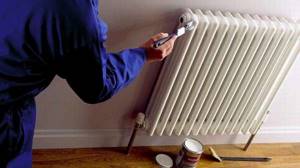
The most suitable time for carrying out repair work is a warm period, when the radiators remain cold, and it is also possible to ventilate the room well.
If it is impossible to postpone painting the radiator until the beginning of the heating season, then you need to wisely choose working equipment and materials. For work, it is better to use a spray can, which allows you to quickly and evenly apply the heat-resistant composition to the surface to be treated. The lower part of the structure and pipes should be treated with a brush.
When choosing paint and varnish products, it is important to consider its quality and performance characteristics. For example, it is better to paint a hot radiator with alkyd enamel
A more affordable and safer option to paint a switched-on radiator is to use a quick-drying acrylic compound. This coating is resistant to temperature changes and high humidity.
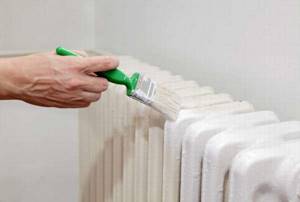
The best way to paint hot batteries
Heating appliances are exposed to hot water and therefore quickly fail. Corrosion occurs on the surface of the battery. To prevent corrosion, the structure is painted with a special paint that can withstand severe temperature changes, creates a resistant film and retains its color for a long time. If renovations are done in winter, then buy paint that does not have a strong odor.
The following compositions are used to paint hot batteries:
- Alkyd. They retain their color for a long time, do not smell and are used for interior work. Alkyd dyes are considered a modern version of oil dyes and have the same curing mechanism. Such dyes are made from alkyd resins, which are produced by heat treatment of oils and polyhydric alcohols. In stores, the compounds are sold mainly in dissolved form. Depending on the type of alcohol, they are divided into pentaphthalic or glyphthalic. Paints are dissolved with white spirit, nefras or orthoxylene.
- Acrylic. They can withstand high temperatures and are used for painting hot heating appliances. The dye is based on polymers. Paints can be water-based or varnished. To obtain elasticity of the compositions and resistance to the environment, additives and fillers are used in their manufacture. The dyes dry quickly, have a slight odor, do not irritate the respiratory system, and working with such compositions is safe for health. These dyes do not lose their color over time; they can even be used in the kitchen, where there is often steam or temperature changes.
- Paint for batteries. There are acrylic compounds that are mixed with a solvent, they create a glossy surface. For painting with such compositions, no preliminary primer is required. The layer dries quickly.
- Oily. Strong and durable, but takes too long to dry. These dyes retain color, but have a strong odor, so they are rarely used for work in apartments.
In addition, the battery can be painted using spray cans of automotive enamel. This method saves composition and makes work easier.
Which batteries can and should be painted?
From the point of view of common sense and to ensure safety, it is mandatory to paint heating devices that are susceptible to corrosion, that is, made of steel and cast iron. But there has long been a tradition that window slopes and window sill niches are painted white, and radiators are also preferred white. In any small store, the entire range of heating appliances is painted white, and only in construction hypermarkets can you occasionally see aluminum or colored radiators.
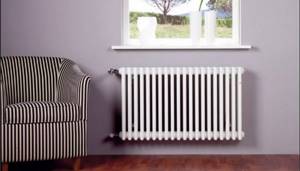
Cast iron
When people talk about painting batteries with their own hands, the first thing that comes to mind is cast iron radiators - reliable, heavy, “eternal.” If you have such radiators in your heating system and are satisfied with the safety of heating your house or apartment, then perhaps you should not change them. If you live in an apartment building, then replacing the heating system may lead to disagreements with the heat supply organization. In a private home, cast iron has its drawbacks, but changing it without reason also makes no sense. But periodic cleaning and painting with your own hands is necessary for cast iron.
Aluminum and bimetallic
You can also paint aluminum and bimetallic heating devices yourself, but this painting is mainly done for aesthetic reasons. To paint aluminum yourself, you need special primers. In bimetal, the steel core is usually not visible, and the aluminum shell is painted.
Copper
Copper batteries oxidize, darken and become less attractive. Therefore, copper radiators and pipes are also painted with your own hands. For copper heating systems, a special primer for non-ferrous metals is used.
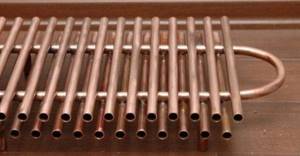
Remove from wooden surface
The main feature of working with wood is that it is a soft material that is easily damaged if treated carelessly.
Having decided to remove the old paint layer from furniture or another wooden surface, first of all you need to understand whether this is necessary
If the old coating is applied in a thin layer and does not have serious damage, you can simply apply a protective primer on it and start painting. Attention! If the coating is in poor condition, it must be removed. This must also be done if it differs in composition from the new paint and is incompatible with it.
If these rules are not followed, both layers may eventually be destroyed.
Old one from the floor
Methods for removing old paint from a floor vary depending on what material it is made of and whether the coating has had time to dry.
So, the most effective way to remove dried paint from linoleum is to cut it off with a sharp knife. If the layer is too thin, use a wire brush or scraper. In this case, you need to act carefully so as not to damage the floor. To make the paint come off easier, cover the stain with a cloth soaked in acetone and leave for 10 minutes.
There are two methods used to clean porcelain stoneware:
- Mechanical;
- Chemical.
The first involves scraping off the paint using a knife, spatula or other tools by hand.
In this case, do not use sandpaper, metal brushes or other abrasives that can scratch the material.
In the second case, chemicals are used that are designed to remove such compounds.
Today there are special cleaners for porcelain tiles on sale that allow you to remove traces of a wide variety of stains.
This is interesting: How long can you store various foods in the refrigerator?
If you need to get rid of old paint on laminate flooring, use White Spirit, solvent or another product with a similar effect. However, keep in mind that they can also have an aggressive effect on the laminate itself, leaving marks on it. Therefore, they should not soak contaminants.
Also, when removing paint, do not use wire brushes or scourers to avoid damaging the finish. Also, laminate does not tolerate moisture. It can only be wiped with a damp cloth, but under no circumstances should it be filled with large amounts of water.
With doors and window frames
Before painting doors and windows, the surface must be properly prepared, otherwise the time spent on the work may be wasted.
Don’t forget, proper pre-treatment prevents the development of mold and mildew, ensuring a longer product life.
One of its mandatory stages is removing the old paint, especially if it has long been cracked and began to peel off.
Information. To remove long-applied coating, in most cases a regular spatula is sufficient. They can remove the largest pieces. When final cleaning the surface from small particles of paint, it is convenient to use a dish net or sandpaper.
However, sometimes it is quite difficult to remove old paint using this method. Heat treatment of the coating helps simplify the task.
It is best to use a heat gun for this, since it is the safest and, moreover, has various attachments that make the work process more convenient.
After removing the old paint, do not forget to treat the surface with special anti-fungal compounds and let it dry. Then you can start applying a new layer.
Acrylic
You can also remove acrylic paint from the lining mechanically. Use a spatula, wire brush or special scraper. To complete the surface treatment, you can use sandpaper or a grinding machine, or pumice.
Alcohol or acetone are also suitable for this purpose. Apply it to the cloth and rub the surface until any remaining paint particles are removed. Then treat the lining again with a damp cloth and let the material dry.
If necessary, the procedure can be repeated after 24 hours. If the paint does not come off well, preheat it with a hair dryer.
Preparing to paint the radiator
Before preparing the battery for painting, you should remember that preliminary cleaning requires not only the old, but also the new battery, where there will always be some unevenness and dirty areas. The surface of the radiator must be thoroughly cleaned and then degreased.
Not everyone can determine when painting radiators can begin without any preparation, and when it is simply impossible to do without all the procedures described above.
To do this, the following three states of the heating radiator can be taken into account:
- The old paint layer does not have any cracks or chips. This means that the previous painting of the heating radiators was done as correctly as possible, so in this case you can proceed directly to applying a fresh coating.
- If the surface of the battery has small areas with chipped and peeling paint, this means that these areas require sanding to obtain a smooth surface, and only then painting.
- Provided that the old coating has come off almost completely, painting radiators can only be done with serious preparatory work, which will require the use of a brush equipped with iron bristles, or a special washing solution with the addition of a certain amount of alkali.
It happens that areas exposed to rust appear on an old radiator. In this case, you can use various kinds of compounds that destroy this plaque, which are always available in any hardware store.
Before painting an old battery, you need to thoroughly wash the heating device to remove dust that has settled on it and treat it with any liquid that can degrease the surface, for example, acetone.
Date: September 25, 2021
Preparation for work and painting
In order to figure out how to paint a radiator, you need to know the principle of this work.
Like any type of work in the construction industry, painting is carried out only after surface preparation. First of all, you need to remove dirt and inspect the product for corrosion.
After removing the old layer of paint and dirt, the battery should be washed with a cloth soaked in water. Swelling areas must be cleaned with sandpaper; if rotten areas are found, be sure to eliminate them.
At the final stage of preparation, the entire surface of the radiator should be coated with primer. If a material that does not require a primer will be used for painting, then this step is skipped.
In order to clean the device from the old layer of paint and various contaminants, you can use one of the following methods:
- mechanical;
- chemical
For a homemade solution you need to prepare:
- 1 kg of soda ash;
- 1 kg slaked lime;
- 5 liters of water;
- 10 liter container.
The solution is prepared simply. Soda dissolves in water at a temperature of 60 degrees. After it is completely dissolved, lime is added in small portions. It must be introduced strictly gradually so as not to lead to the formation of a large amount of foam.
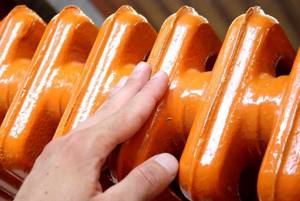
To paint batteries yourself you will need some material.
In the mechanical method, sandpaper or a special scraper is used. Manually cleaning the surface is quite difficult and time-consuming. You can use a special attachment for a drill or a grinder
In this case, you must strictly follow safety rules and act very carefully so as not to damage the battery.
When thinking about how to paint a hot radiator and whether it can be done without special skills, you should not be afraid. Even a beginner can handle this, you just need to know the basic rules of operation.
Before painting, you need to prepare your work area, lay polyethylene or newspapers on the floor, protect the wall by attaching thick paper or cardboard to it, and also prepare your tools.
The paint is applied with a brush in smooth movements from top to bottom - this way you can paint warm radiators without leaving streaks. The layer must be made thin and even. After the first layer has dried, the second is applied.
It is recommended to paint the internal surfaces of the battery first, so as not to get your hands dirty in the process. If it is difficult to do this with a brush, then you can use a small roller or even an old toothbrush with a bendable head.
How to paint heating radiators: water-based emulsions, universal enamels, anti-corrosion primers
You may have already faced the question of how to paint radiators, and if you solved it, then that’s, of course, good. If not, then you will find out about it now. The peculiarities of such painting work lie not only in paint and varnish materials, but also in finishing tools, as well as the heaters themselves, which can also be different.
So, if you want to choose a paint composition that is exactly suitable for your case, stay with us. And the video in this article will complement our material with visual information.
Painting radiators: a creative approach
Other types of paint for heating radiators
Heating devices can also be painted with compositions based on aluminum or silicate resin. This coating is quite dense and elastic, which does not crack due to temperature changes. Silicate paint is applied to the surface without pre-treatment with a primer and is resistant to extreme heat.
The disadvantage of such coloring compositions is the presence of a strong unpleasant odor, so it is important to correctly determine when it is best to paint batteries.
One of the varieties of alkyd compositions is hammer paint. After this paint, the surface acquires an interesting, but rather specific appearance, with an embossed effect.
The heterogeneous structure of hammer paint allows you to hide unevenness, roughness and other minor defects in heating devices. This problem is especially relevant for those who cannot decide what paint to paint cast iron radiators, since the original coating completely hides their rough surface.
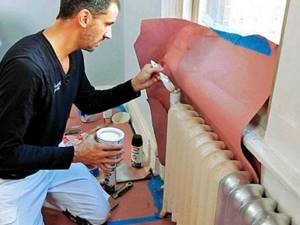
Another option for painting radiators is silver, which is a mixture of varnish and aluminum powder. This coating is resistant to high temperatures and can be applied to a primed surface or old paint. The disadvantage of silver is its persistent odor; therefore, painting must be done in a well-ventilated area. It should also be remembered that aluminum powder is an explosive substance, which makes preparing the composition yourself risky. The presence of small children or flammable objects is undesirable.
Radiator paints and necessary tools
Many people believe that only the front part of heating radiators should be painted, but, unfortunately, this conclusion is erroneous.
Often, especially with Soviet batteries, rust spots begin to appear, and if they are not eliminated, the corrosion can spread further.
Good paint will help get rid of unwanted corrosion. To find out what paint to paint radiators with, you need to find out the characteristics of this product.
The purchased paint must be resistant to elevated temperatures, because radiators get very hot in winter, and maintain a natural color for a long time.
To choose the right paint and varnish material, you need to know what types are available for sale.
Acrylic paint has a natural color over a long period and is famous for not having a strong odor.
This option is well suited for painting radiators in winter, because you don’t really need to ventilate the apartment.
Alkyd paint has high temperature resistance and is therefore ideal for radiators. One of the disadvantages is the increased smell, so it is better to use it in the warm season, and not during the heating season.
There is another type of acrylic paint that is used in conjunction with a solvent. This material has good performance, firstly, the paint can be used without additional primer, and secondly, the coating has a good appearance and a glossy surface.
The well-known oil paint used to be a popular product, but with the development of the technological process it faded into the background.
This is the main list of paints and varnishes for cast iron radiators that can be purchased. For panel radiators, you can use aerosol paints (preferably auto enamel).
It is no longer fashionable to have white batteries, so do not be afraid to experiment with colors, the main thing is that the coating fits into the design of the apartment.
In a children's room, you can decorate radiators brightly, especially panel radiators, on which you can reproduce the whole landscape.
So how to paint radiators and in what style is up to you.
But it should be remembered that in order for the coloring material to adhere well, you must have a special tool, such as:
- sandpaper for pre-cleaning;
- a sharp object or knife to remove old paint;
- several types of brushes;
- small roller;
- unnecessary rags for cleaning the room.
This entire set will be needed for high-quality work and will help transform old and ugly radiators into a luxurious piece of furniture.
Painting the battery outside the heating season
Preparation
The first step is removing the old paint. Due to the fact that the design of the battery makes many of its places difficult to reach, it is not possible to clean it the old-fashioned way using a metal brush.
A soldering iron or hot air gun will not work. Since in the first case the structure can be damaged, and in the second it is simply useless.
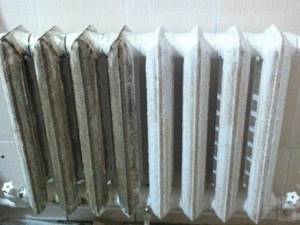
Paint remover can remove paint even in hard-to-reach places
Of course, this method also has its drawbacks, but it still gives the best results. The remover works on the principle of a solvent. It penetrates the paint layer, softens it and then scrapes off the old paint quite easily with a putty knife or metal scraper. Among other things, the remover does not damage metal or wood, so it can be used before painting the batteries.
How to paint batteries:
The process of painting radiators
- apply wash;
- remove old paint;
- rust must be sanded off;
- treat the battery with a degreaser (white spirit or slightly alkaline solution);
- if necessary, apply a primer;
- After drying, you can apply the main color.

Recommendations on how to paint cast iron batteries with your own hands
- Batteries should only be painted when they are cold. Therefore, it is better to postpone all work to a time when the heating season has already ended. If the need arises in the autumn-winter season, turn off the valves and wait until it cools completely.
- If you have to apply paint to warm radiators, use a spray can or apply a very thin layer. The whole difficulty of applying paint to a hot surface is that brush marks remain. In addition, the paint may change color and the batteries will become stained.
- Radiators can only be connected after the paint has completely dried.

How to choose the right paint for heating radiators:
Instructions for painting batteries
At the first stage, you need to purchase tools, remove old paint, clean and prime the surfaces. After this, you can begin staining.
Tools and consumables
To process radiators you will need:
- brushes;
- brush attachments;
- sandpaper;
- degreaser;
- primer for metal with anti-corrosion additives;
- solvent of the desired type;
- abrasive for removing a thick decorative layer.
Cleaning the radiator from external contaminants
The batteries are washed with soapy water, removing traces of dust and dirt. Before removing paint from surfaces, dry them.
Removing old coating
To remove the cracked layer, you can use sandpaper or a brush attachment. If particles of old paint remain after processing, the recesses between them are sealed with metal putty.
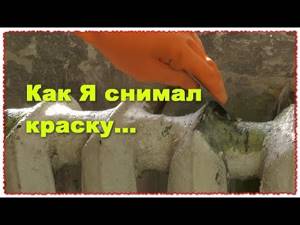
Sanding the surface
This action is required to obtain an even coating. Sanding of radiators begins after the putty has completely dried. All radiator elements are cleaned with sandpaper.
Primer coating
At this stage, perform the following actions:
- Degrease the metal with white spirit or a weak alkali solution. Wait for the product to dry.
- Apply the first layer of metal primer. After drying, you can begin re-processing.
Applying dye
When painting, observe the following rules:
- Before starting work, turn off the device. The radiator temperature should be equal to room temperature. However, the metal cannot be cooled below +15 °C. This prevents polymerization and drying of the coloring agent.
- It is advisable to disconnect and remove the battery. This will help coat back surfaces and hard-to-reach areas evenly.
- Do not forget about processing the internal and lower parts of the radiator.
Coloring is done as follows:
- Use a thin brush to cover the inner ribs. You need to rub the dye thoroughly. There should be no leaks.
- Wait until the product dries and apply a second layer on top. At the same time, the front sides of the sections are processed. It is advisable to apply several layers of paint so that there are no gaps.
- Dry the coating for 12 hours. At this time, you cannot connect the battery to the heating system. Correctly applied paint will last at least 5 years.
What to paint: types of enamels for cast iron radiators
Heat-resistant enamels for cast iron batteries are produced on the basis of resins (alkyd, acrylic, silicone), water dispersions (acrylic and silicone); there are also powder paints, but their use requires special equipment; painting is done in a factory.
For painting at home with your own hands, acrylic compositions (water-soluble or organic solvent-based) and alkyd are popular.
Alkyd
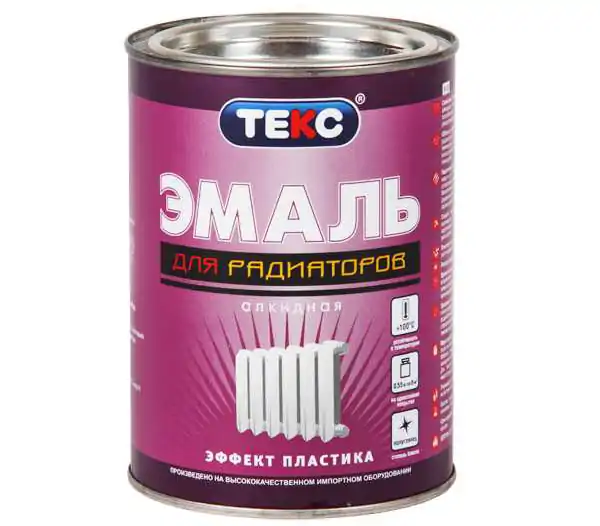
Photo 1. Alkyd enamel for cast iron heating radiators with a plastic effect from.
The disadvantage of enamels is the drying time and the unpleasant odor that persists in the room for several days; it can appear at high temperatures of the coolant; enamel cannot be called harmless.
Reference! Alkyd enamel is applied in 2 layers to a pre-primed surface with a brush or using a spray gun.
Water-dispersible acrylic
Water-based acrylic enamel dries quickly, the paint layer is smooth and even, like plastic. It is odorless, does not burn, is safe and environmentally friendly, and has high adhesion to metal.
The disadvantage of acrylic water-dispersed enamels is their instability to abrasives (the surface cannot be cleaned with powders).
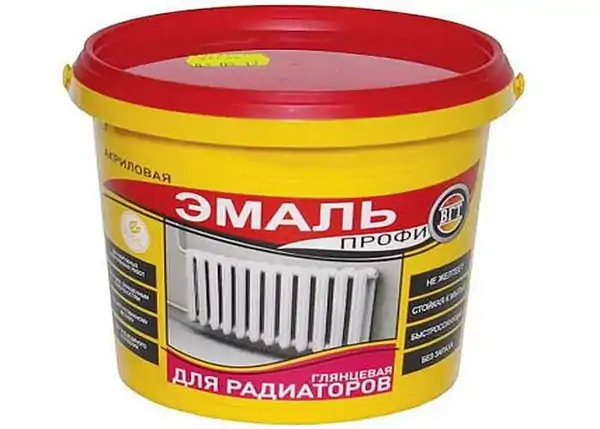
Photo 2. Acrylic glossy enamel for cast iron batteries PROFI VD-AK-1179 dries quickly and leaves no odor.
Acrylic with solvent
In addition to acrylic resin, the composition includes pigments, additives and a solvent – white spirit. The enamel forms a durable and stable coating; the paint can be applied to surfaces previously treated with acrylic or alkyd. The layer is durable and does not turn yellow over time.
The disadvantage is the unpleasant odor and the drying time - the painted surface dries in about 8 hours, the second layer is applied a day later.
Odorless paint for radiators
These are water-dispersed acrylic paints/enamels without odor. Or rather, the smell is present, but not very pronounced, and different from what we are used to. But you only need to buy a special composition for radiators (or the area of application must indicate that it is suitable for painting pipes and heating radiators, and the temperature regime must also be indicated) and nothing else.
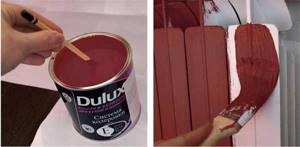
You can even paint new batteries - if the color doesn’t suit you
The advantages include a high drying speed, as well as ease of application - they lie flat, do not turn yellow or crack, since the coating is elastic. There are glossy and semi-gloss types.
A good paint of this type is Master Lux Aqua 40 Dulux, it costs about 2,000 rubles for a 2.5 kg can. For the first layer you need to dilute with water 1*10 (one part water to 10 parts paint). All subsequent layers do not require thinning.
Element (Eskaro), Aqua-Heizkorperlack (Dufa) also performed well, there are odorless acrylic ones “Composite”, “Dufa” - “DufaRetail” Thermo, Triora”, etc.
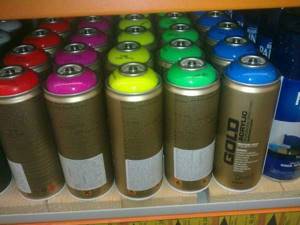
You can use paints in spray cans. With some skill they are applied evenly, but before work you need to cover everything around with old wallpaper or newspapers
Read about how to prepare the radiator surface for painting here.
How to paint radiators: preparatory stage
So, the materials have been selected. Now you can move on to the preparatory stage. Old cast iron radiators may have chipped paint and many layers on top of them, so you need to completely clean the radiator from the old paint to the metal. This operation can be performed using a hair dryer, which melts the old paint with a stream of hot air, after which it can be removed using a spatula.
If you don’t have a hairdryer at hand, you can use an alternative option - a washing solution. This solution is applied to the entire surface of the radiator, after which the heating device is covered with a film. After the washing solution has been in action for an hour, the paint can be removed using a spatula.
The main layer of paint has been removed, now we clean the battery from its remnants using fine sandpaper or a special wire attachment for a screwdriver. Then degrease the surface of the radiator using a rag soaked in a special solution, such as white spirit. The final stage is to coat the radiator with an anti-corrosion primer; it will protect the radiator from corrosion, but will also improve the adhesion of the paint to the surface.
Preparatory work
It is necessary to prepare the surface for painting in advance. The quality of the coating depends on this.
When preparing a radiator for painting, perform the following work:
- First you need to clean the heater from dirt.
- The battery is then inspected to look for rust.
- Then, using a scraper and sandpaper, remove the old paint.
- After the surface of the battery is cleared of the old coating, the battery is treated with a primer solution.
- Then a primer is applied, this will level the coating, remove unevenness, and ensure adhesion of the paint to the surface.
- The primer is chosen depending on the type of paint.
- The work area is covered with cellophane, and both the floor and the wall should be covered.
The main difficulty of the preparatory stage is removing the old paint. There are several methods for removing old coating. The most accessible is the chemical method.
To prepare a chemical composition for paint removal you need to prepare:
- 1 kg of calcined salt;
- 1 kg lime;
- 5 liters of water.
The washing solution is prepared as follows: pour hot water into a 10-liter container, add soda, stir it, add lime in small portions, mix the solution and leave for 10-15 minutes. This solution is applied to the heating device, left for 5-10 minutes, and then the paint is removed with a scraper.
The mechanical method of removing paint from a radiator is based on the use of a drill with an attachment. During work, do not press hard so as not to damage the metal. When the preparatory work is completed, painting begins.
Direct dyeing process
During the work, use two brushes, one for painting the main surface, the other for applying paint in hard-to-reach places. The second version of the brush has a long curved handle, so the back walls and internal surfaces can also be painted easily and simply. Before you start painting, the bristles of the brushes must be well fluffed. This will remove hairs that are poorly attached to the base of the brush.

First of all, paint is applied to the internal parts of the radiator: first paint the top part, then go down. When painting the outer surface, work is also done from top to bottom. Otherwise, drops of paint will fall on the applied paint.
Painting instructions
- First you need to check that the floor and walls are protected from dye.
- If necessary, add additional cellophane.
- First you need to study the instructions for the coloring composition, stir the mixture to obtain a homogeneous consistency.
- Begin painting from hard-to-reach areas. To do this, use narrow brushes with a curved handle.
- The outer part of the battery is painted with a roller or wide brush.
- You need to paint from top to bottom, this way there will be no smudges and the composition will not splash to the sides.
- To get a high-quality coating, you need to apply 2 layers of paint.
- The second layer should be applied only after the previous one has completely dried.
Things to consider
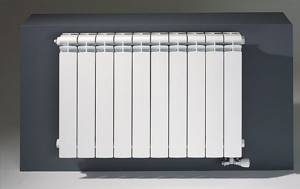
Aluminum radiators
Please note that painting modern aluminum radiators that were originally painted in the factory is not the best option. The thing is that at the factory, paint is applied to heating devices in a certain way using special equipment, which allows the surface of the heating element to be evenly coated by spraying with a thin, especially durable film, which in turn ensures uniform heat transfer.
And if you apply paint to the surface of the radiator yourself, you will, one way or another, disrupt the thermal conductivity characteristics of the heating element.
Choosing the Right Paint
When choosing paint for heating radiators, you should take into account several requirements that the product must meet:
- Heat resistance. Since batteries are, in principle, a heating device, the paint must be heat-resistant. Keep this in mind when choosing paint that is resistant to high temperatures.
- Non-toxic. When heated, paint can emit an unpleasant odor as well as toxic substances that can cause allergies, headaches and even poisoning.
- The shine of the paint is provided by acrylic, but it is worth remembering that when painting the room there will be a rather pungent odor. An unpleasant odor may not disappear for quite a long time - the room must be ventilated for several days. Follow safety precautions when working with paint
Features of choosing paint for heating batteries
When purchasing paints for radiators, you need to consider the following characteristics:
- hiding power (the consumption of the product depends on this parameter);
- heat resistance (preservation of properties when heated);
- color stability;
- drying time.
The paint is selected in accordance with the material from which the heating system elements are made:
- It is recommended to paint aluminum, steel and bimetallic products with acrylic or alkyd enamels. Water-based products are also suitable.
- Cast iron batteries can be painted with any composition. However, the product must be distributed in a thin, uniform layer, so thick paint is mixed with a thinner.
You should avoid using oil paint, even if it is produced by a trusted manufacturer. This product does not perform the required decorative and protective functions; it smells unpleasant when heated.
Painting a radiator with a normal paint coating
If the paint is in normal condition without visible flaws, if there is only one layer (or two) and they lie flat, you can paint on top without removing the old coating. Only pre-treatment is required.
Painting an aluminum and bimetallic battery
If you want to paint an aluminum or bimetallic battery, in which you are not satisfied only with the color, think carefully about whether it is worth spoiling the good coating. Maybe it’s worth covering the radiator with a screen in this case? And one more thing: if your radiators are under warranty, then after painting the factory (or seller) will refuse warranty repairs. Even if the reason is completely different.
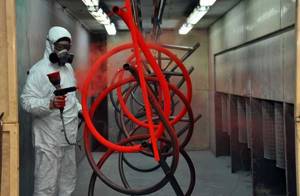
If you want to get a color similar to the “factory” one, contact a specialized service station. They paint cars using the same technology. Maybe they will agree to paint your radiators
If you still need to paint an aluminum or bimetallic radiator, it is better to contact a specialized auto repair shop. Only they can help professionally. If you want to do everything yourself, you can use spray paint for cars. But with this option, there is a possibility that in those places where the radiator is often touched, the top layer will wear off, although it depends on the quality of the car enamel and the starting coating of the radiator.
If you still decide to use auto enamel, you need to work on hot batteries. And the hotter the better. Drying time at 130oC is 20 minutes, at 60oC - 40 minutes, and at 20oC - a month.
Important condition: during work and all the time while the paint dries, the window must be open, the doors to other rooms must be closed. Please wear a mask and gloves when working

There are a lot of paints in cans, but you need to spray them on hot batteries
Everything around will have to be covered with paper and old rags. The can is a good thing, but it was almost turned in the wrong direction, and everything is painted to match the radiators... While working, keep the distance required for uniform spraying - it’s about 20-30 cm, but it’s written exactly on the packaging. And in general, even before purchasing, carefully read the instructions and recommendations for use. This way you will understand whether you can provide the required conditions for applying paint.
The order is the same: start with the inner surfaces, then go over the outer ones from top to bottom. Don't try to get the color perfect the first time. This is almost impossible, especially if the base color is white and some bright shade is applied to it. If you keep the stream in one place for too long, sagging and drips will appear. They are much more difficult to deal with than unpainted areas. It is better to apply one or two more layers after complete drying. The result will be better.
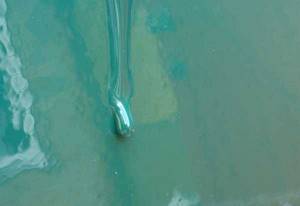
If you hold the stream in one place for a long time, or bring the spray can close, you will get a drop like this
Changing the color of cast iron
Most often, old-style cast iron batteries need painting. It is definitely better to carry out the work after the end of the heating season: it will be safer for you and the painting will be of better quality. Then the order is:
- Completely and thoroughly clean the radiator from dust and dirt. This is done “dry” - with a vacuum cleaner and brush. If there are stains that cannot be removed this way, try water with detergent. Grease can be easily removed with dishwashing solutions or special acidic agents. This is far from the easiest and most pleasant process, but if you do not remove the dirt, there will be bumps and uneven spots under the paint. That’s why we clean it diligently. Let the battery dry.
- Then remove the top layer of paint with sandpaper. This is necessary to create a rough surface. This is the only way the paint will lay down evenly. You don't need to strip off the paint completely as long as it's smooth and free of cracks. Use fine sandpaper to roughen the surface, leveling out any minor imperfections if necessary.
- Wash off the dust with water and let the radiator dry.
- Coat everything with a primer compatible with your chosen battery paint and wait until it dries.
- Apply paint with brushes in several thin layers.
Painting a panel radiator
There may be two options here. If there is a factory sprayed enamel, it is better to use a can of auto enamel. If the paint is ordinary, the procedure is the same as for cast iron. The only difference is that it will be easier to paint the front panel with a roller rather than with brushes.
But in panel radiators you also need to change the color of the grilles. They will need to be painted with brushes. If there is rust on the gratings, they should first be cleaned, then treated with a rust converter, primed (with a composition with an anti-corrosion effect), and only then painted. The easiest way to buy all these products is at the car market - there are a lot of them in different packaging.
The best water-based paints for radiators
Acrylic paint for heating radiators Radiator Festek
The products are offered by a Ukrainian manufacturer. The type of composition is one-component, but it guarantees increased resistance to the adverse effects of water. Allows you to improve the external condition of heating radiators thanks to a pleasant matte snow-white shade.
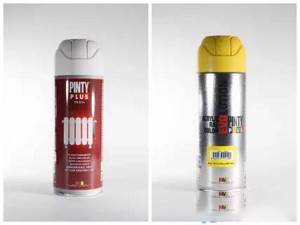
Pros:
- absence of any odors;
- increased resistance to water washing and dry abrasion;
- the ability to completely paint heating batteries without further influence of external factors;
- resistance to yellowing;
- the ability to withstand heating up to 95 degrees Celsius;
- minimal drying time, which speeds up the procedure.
Minuses:
- vulnerability to high operational loads
Washable odorless semi-matte paint Remontti Assa Tikkurila
These paint and varnish products are offered by a well-known Finnish manufacturer, which takes into account current standards and successfully produces high-quality modern paints for the further processing of heating batteries.
The composition is created using an acrylate binder. At the same time, the manufacturer refused to use organic solvents. This approach to the creation of paint and varnish products contributed to the receipt of the “Eco-label” of the European Union. The Association of Allergy and Asthmatic Disease Specialists of Finland participated in the development, as a result of which the products are completely safe even for allergy sufferers and asthmatics.

Pros:
- created from high-quality components and modern technologies;
- high level of safety, due to which the use of products is justified in most cases;
- resistance to washing and abrasion.
Minuses:
- very high price, so such products are not available to all potential buyers.
Acrylic enamel for heating radiators Farbex Polisan
The products are offered by the famous Ukrainian manufacturer Polisan, which tries to take into account current standards and offer only high-quality paints and varnishes. It is assumed that it is possible to carry out decorative and protective painting of heating devices.
Pros:
- requires minimal time to dry;
- It has a snow-white hue and a pleasant glossy finish, and the original color remains for a long time;
- optimal adhesion to various types of surfaces is guaranteed;
- there is increased resistance to frequent repeated washing;
- additional treatment with pigment concentrates is available, as a result of which the heating device can fit perfectly into the design of the room;
- no pungent odor;
- The content of volatile organic compounds complies with current standards, therefore the products are recognized as safe.
Minuses:
- the radiator must be thoroughly treated before further painting, and dust, rust, scale, grease and other contaminants must be excluded;
- surfaces that were previously painted with alkyd or oil paint must be carefully treated until matte and degreased;
- preparing paint requires a careful approach and effort, strict adherence to the instructions and certain room conditions (air humidity should not be lower than 80%, and the surface temperature should be from +10 degrees).
- Correct use of paint justifies its choice for further use and successful treatment of used heating radiators.
Paint for radiators Balakryl Radet
The Czech brand Balakryl offers high-quality paint that is ideal for treating heating radiators in modern heating systems of residential and industrial premises.
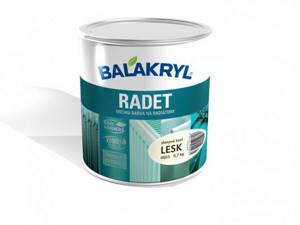
Pros:
- increased resistance to the adverse effects of water;
- possibility of use in rooms where there is a high level of humidity;
- The heat resistance exceeds 100 degrees, therefore the safety and long-term preservation of the original condition of the heating batteries is guaranteed.
Minuses:
- not identified.
Is it possible to paint hot batteries?
Many professionals do not recommend painting radiators at the height of the heating season. However, using alkyd enamel, resistant to high temperatures, or sprayers, it is quite possible to paint hot batteries
You just need to do this carefully, carefully and quickly, so as not to get burned and so that the paint lays evenly. The latter is quite difficult to do, since on a hot surface from 50°C it dries almost instantly
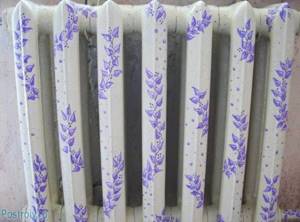
Option for painting a heating radiator - Photo 3
If you doubt that you can quickly and accurately complete the procedure, it is better to wait until the end of the heating season. Or, if time is running out, do not immediately paint hot batteries, but first turn on the heated water supply to them. Moreover, if you cannot do this yourself, you can contact the Housing Office.
Paint consumption for hot batteries
Each paint manufacturer indicates on the can the recommended consumption per 1 m2. If we take a section of a standard MS-140 cast iron battery, then its area is 0.21 m2. By adding up the number of sections, it is easy to calculate the consumption of paint and varnish to cover the entire heating device in one layer.
To paint a seven-section battery in one layer, you need about 150 g of Celsit-500 enamel.
Taking into account the fact that the work is carried out during the winter heating season, the liquid coating composition evaporates faster from a hot radiator, and the viscosity increases. The cost will be slightly higher. It is necessary to provide for a reserve. It is difficult to calculate accurately, since it all depends on the type of coloring material, battery temperature, and the number of layers applied.
